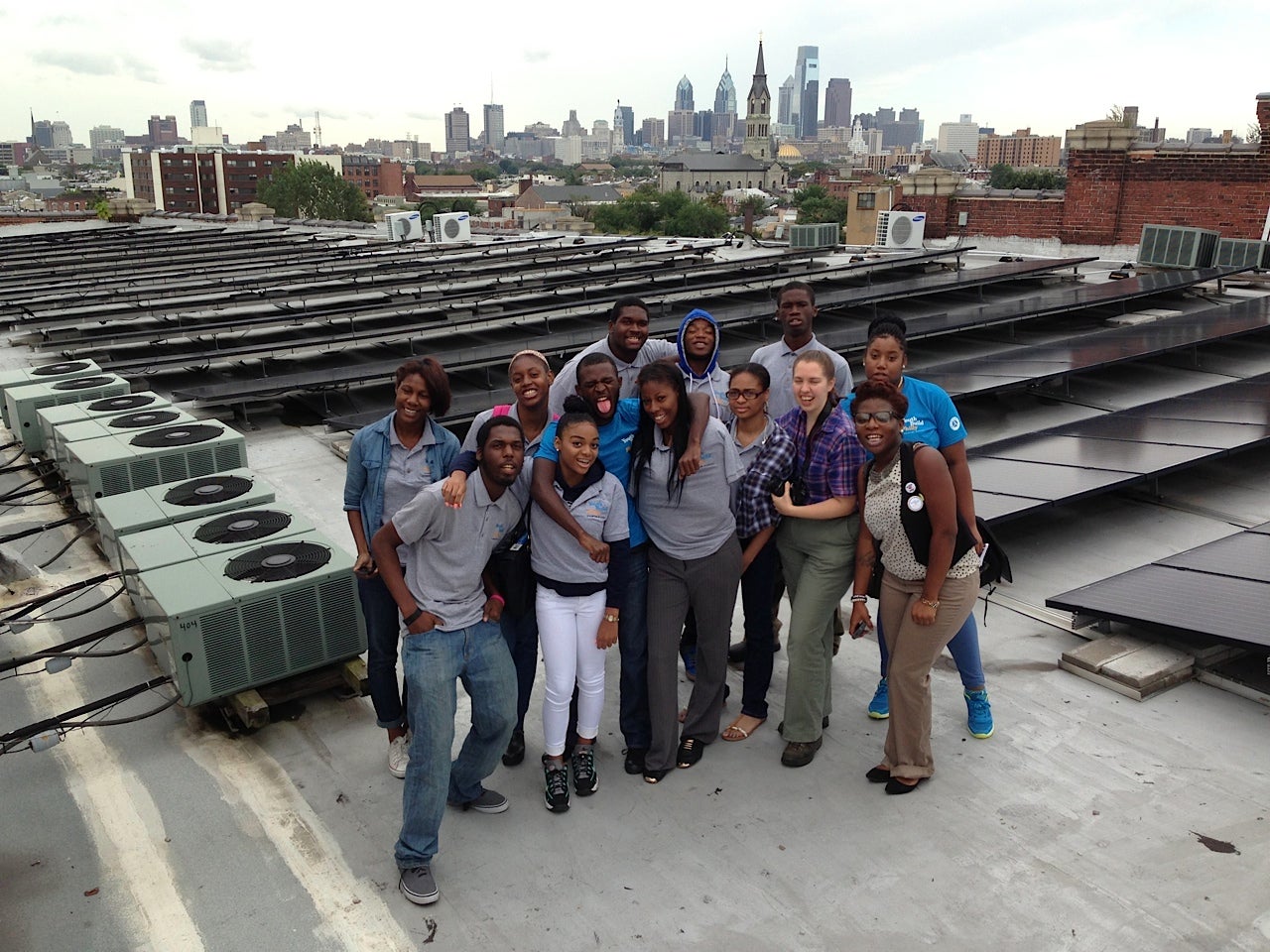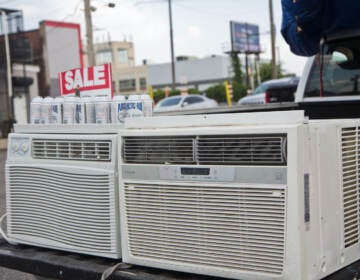City releases reworked sustainability agenda calling on all Philadelphians to participate

The city’s new comprehensive sustainability plan is no longer aiming to make Philadelphia the greenest city in America, the goal set by mayor Michael Nutter when Greenworks launched in 2009. Now the goal is to make city more equitable and sustainable for all Philadelphians.
This goal is no less ambitious, Director of Sustainability Christine Knapp told PlanPhilly, and it’s aiming to be fairer. Competing with other cities against different kinds of metrics doesn’t necessarily make the city better for its residents, Knapp said, but comparing the benefits that every neighborhood receives within the city, does.
“We recognize that we’ve made a tremendous amount of progress in a lot of different areas, but we also recognize that not every neighborhood in Philadelphia has received those benefits,” Knapp said. “So we want to make sure that everybody, in every zip code of the city, is able to benefit from our work in an equitable way.”
NEW GREENWORKS VISIONS:
All Philadelphians…
- Have access to healthy, affordable and sustainable food and drinking water;
- Breathe healthy air inside and outside;
- Efficiently use clean energy that they can afford
- Are prepared for climate change and reduce carbon pollution
- Benefit from parks, trees, stormwater management and healthy waterways
- Have access to safe, affordable, and low-carbon transportation
- Waste less and keep our neighborhoods clean
- Benefit from sustainability education, employment and business opportunities
One of the goals of the new Greenworks is to launch, by next spring, an Equity Index to identify communities that are not benefitting from the sustainability efforts taken so far, with the goal of improving their access to well-maintained parks and sideways, healthy food and water, and cleaner air and streets.
Seven years ago, Greenworks established 15 measurable targets and more than 160 specific initiatives to meet by 2015. Last year’s final report found that the city exceeded four of the goals, met one, came close to two, moved forward in four, and didn’t achieve another four.
Knapp, who was appointed to direct the Sustainability office last January, thinks overall there was a lot of progress. “We reduced city greenhouse gas emissions by 9%, we tripled the city’s residential recycling rate, we launched Indigo and added new bike infrastructure, and we also managed over 800 acres of land for stormwater management,” she said.
But after five community meetings and five meetings with issue experts and stakeholders, an English and Spanish survey with 300 responses, a Twitter chat on Earth Day, and an open house, seeking people’s feedback on future directions for Greenworks, the Sustainability office decided to take a different approach.
“The biggest message we got was to try to simplify it, and to try to make it more directly connected to the average person’s life. To see this report as something that speaks not just to academics, or environmental organizations, but to everybody who lives in the city,” Knapp told PlanPhilly. “People wanted to know how they could help and contribute.”
The plan acknowledges and addresses the local impacts of climate change “the biggest environmental challenge of our generation,” and mentions cutting energy waste and investing in renewable energy as ways of reducing the harms. But to really adapt to these changes, Greenworks acknowledges that the work has to be done by everyone, not just the local government. That’s what one-page guides called Greenworks on the Ground will try to achieve, with actions to contribute to the solutions targeted to individuals.
“Climate change is a difficult topic because a lot of people either don’t think it affects them daily or they feel overwhelmed by it and they don’t know what to do,” said environmental scientist, Raluca Ellis, director of the Climate and Urban Systems Partnership, a five-year, multi-city project focused on engaging the community with climate change, led by The Franklin Institute. “This plan [Greenworks] gives people a chance to take part of the process and take ownership. The ability of participating can make people more hopeful about the future.”
Matthew Stepp, Director of Policy at PennFuture agrees. “You almost needed a master’s degree to understand the previous one,” he said. “And that doesn’t necessarily work when you are trying to work with the community.”
The new Greenworks doesn’t have targets but “visions” – a word that Knapp hopes can engage people better. Each vision includes how it will benefit Philadelphians in four areas – equity, health, environment, and economy; measures to define progress; a section for regional, state and national factors that help or hinder progress; the city’s commitments to make annual progress toward a vision; and a final section of what people can do.
Instead of including metrics with specific goals on the plan itself, the Sustainability office decided to have them on an online platform called Greenworks Dashboard where they could be regularly updated.
“We don’t want to move away from that accountability, and we are including ways to measure our progress,” Knapp said. “But some [visions] have goals and some of them have goals to set goals.”
The city will develop tailored strategies for each of the new Greenworks visions in the coming years, although the report will be updated every year. For this year, the plan is to approach the Rebuilding Community Infrastructure initiative, the Kenney administration’s effort to improve civic assets, with an eye on sustainability. By the first half of next year, Knapp wants to complete an Energy Master Plan with policies on energy efficiency, renewable energy, carbon emissions and other metrics. In 2017, the city will create a Litter Plan, setting waste reduction goals, and a Shared Food Metrics study to measure progress on the food system work in the city. Finally, the Office of Sustainability is looking for funding to complete a Transportation Master Plan centered on the impact on climate change and health.
“I’m happy with it,” Stepp, said. “I don’t think is less ambitious, and I think is more focused.” Reducing carbon emissions is the biggest challenge, he said, and he’s pleased to see Greenworks 2.0 keeping that target as a priority with practical steps such as having energy efficient buildings, more solar energy, LED street lighting, and lower carbon transportation.
He also prefers the simple approach. “The old one has a lot of metrics, but didn’t meet all of the goals maybe in part because they weren’t engaging the general public,” he said.
Sustainable Business Network’s executive director Jamie Gauthier said the new grassroots and community approach taken by Greenworks is what really needed to happen. “We have some really ambitious goals, to be the most sustainable city in the country, and we are not going to be able to achieve them without the help of the community,” Gauthier said. “At the end of the day, if we are going to move forward as a city, we depend on the actions that people take in their lives. And if they don’t understand the goals or how they affect them, that’s not going to happen.”
Gauthier is pleased to see that a number of SBN’s recommendations made into the plan: a broader citywide approach to the Green City, Clean Waters plan, a pathway to clean energy jobs, an increased focus on sustainable and local procurement, and an expansion of energy management in the residential sector.
WHYY is your source for fact-based, in-depth journalism and information. As a nonprofit organization, we rely on financial support from readers like you. Please give today.





